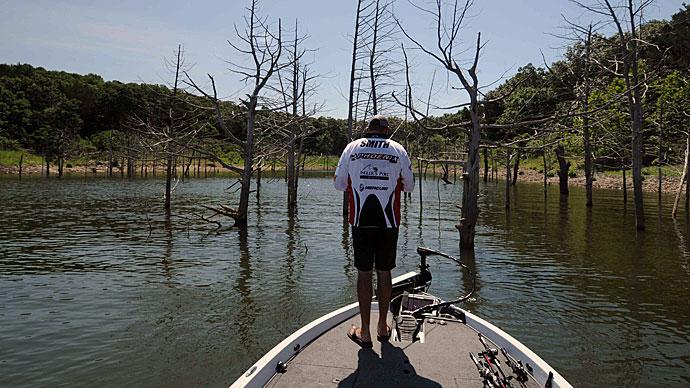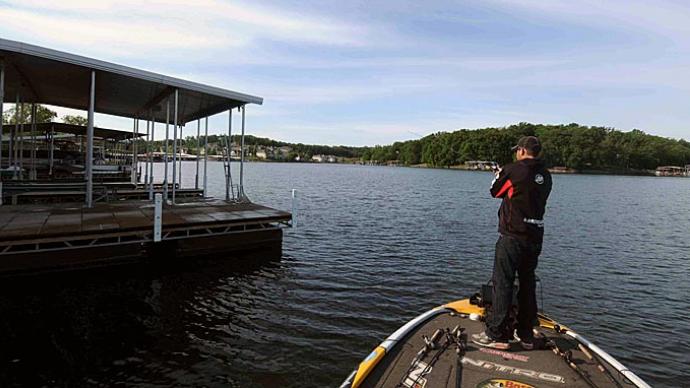
You launch the boat, set the rods around the front deck, and start thinking about the first place you'll start fishing in search of that first bass. Most anglers would start by throwing topwaters in the shallows around visible structures. Although this technique is great to start with, you need to ask yourself where you will go next. As a bass angler, you have to be two steps ahead. You have to be thinking about what you're doing now, but you also have to be aware of where you plan to fish next and where you plan to fish after that.
Some of the most overlooked areas to fish are wooden docks. Most lakes and reservoirs have wooden docks on them, and many anglers pass them over in favor of other areas. Wooden docks provide shade and shelter, and since most lakes have significant populations of crappie, it's a safe bet that at least 85% of the docks will have brush around them and underneath them.
After that morning bite tapers off, look toward the older wooden docks. Docks with rotting pilings that have plants growing from them and docks with algae growing on the sides of the pilings will produce best. There are times when several of these docks are in a row, and finding something different about one dock will often outproduce all the rest.
To find out which dock will produce the best, explore as many docks as possible with several different lures. Sometimes, one feature that makes one dock different from the next will be hidden. Some of the lures that will give you the edge in exploring docks include spinnerbaits, jigs, Texas-rigged soft plastics, and Senkos. Although Senkos can be put under Texas-rigged soft plastics, I also use Senkos on a wacky rig.
Use the spinnerbaits by running them along all the edges of the docks, the outsides of the docks, the edges where an inside edge meets the outside edge of the dock. After the post-spawn, the bass will position themselves on these edges and chase baitfish. The most productive color is white with a pair of willow-leaf blades. If the water color is dirty, switch to a chartreuse-white spinnerbait, keeping the willow-leaf blades. Fish from depths from 1- to 5-feet along these edges.
Jigs and Texas-rigged plastics are two lures that can be fished in the same locations within a dock, but both have their own time and place. Both can be fished alongside the pilings on the outsides of the docks, but usually, I will fish the jigs in these locations. Both can be fished in the heart of the brush that is put under the docks, but in those places, I feel that the soft plastic lures will produce because the soft plastics won't slam through the brush. Instead, they will gently lay and swim around the brush. Another way to fish soft plastics around docks is to swim them along the edges in deeper water than what you would fish the spinnerbait.
Senkos are one lure that I have had the most success with when fishing docks, especially in the summertime. Bass will position themselves in all depths of the water, mainly in the shade of the dock, and will wait for baitfish to swim by. Rig a 5-inch Senko on a #1 or #2 hook, hooking it through the middle of the bait. To find the exact middle, put both ends together, and place the hook where the worm bends. Some people place the hook in the egg sack, but I feel that this will cause the lure to be lop-sided and affect the lure's action.
Once you have the lure rigged, fish it by allowing it to flutter to the desired depth and then sharply jerking it up with the rod. Allow the lure to flutter back down, and experiment with the retrieve until you find which presentation the bass prefer.
Fish the spinnerbaits, jigs, and Texas-rigged soft plastics on a 6-foot 6-inch or 7-foot medium-action rod, with a high retrieve and high gear ratio reel. Use braided line to give an excellent feel for what the lure is doing. I would use a braided line that is no smaller than 30-pound test due to the gnarly cover and rough pilings associated with wooden docks.
As for the Senkos, I would use a 6-foot 6-inch spinning outfit with a braided line around a 20-pound test. Heavy lines on spinning outfits can sometimes affect the presentation of the lure.
Fishing docks are a great way to put a good limit of bass in your livewell, as long as you're willing to be patient and work each dock thoroughly. Finding the dominant pattern is of great importance. Fishing wooden docks is a great way to find bigger bass as well.
The next time you're out on your home waters, check around for the oldest wooden docks and start fishing them if you have not done so previously.
As always, best of luck and be safe out on the water.




